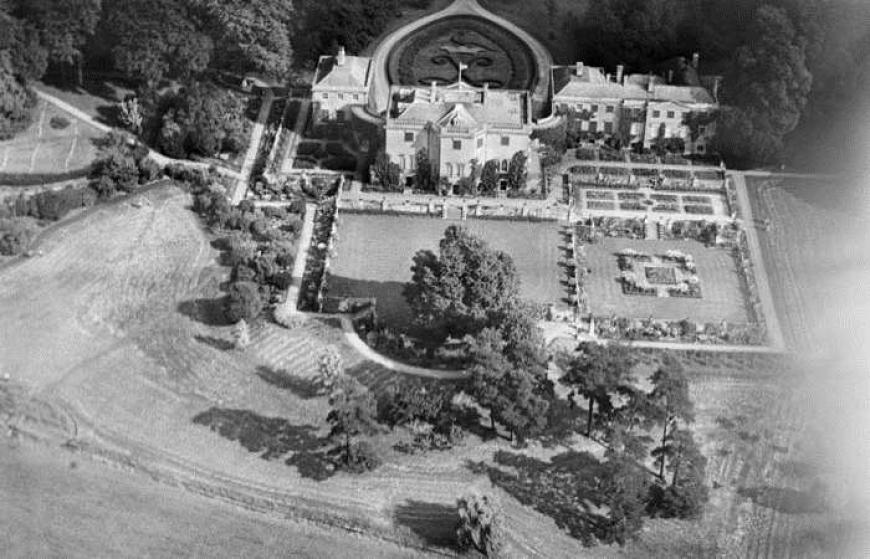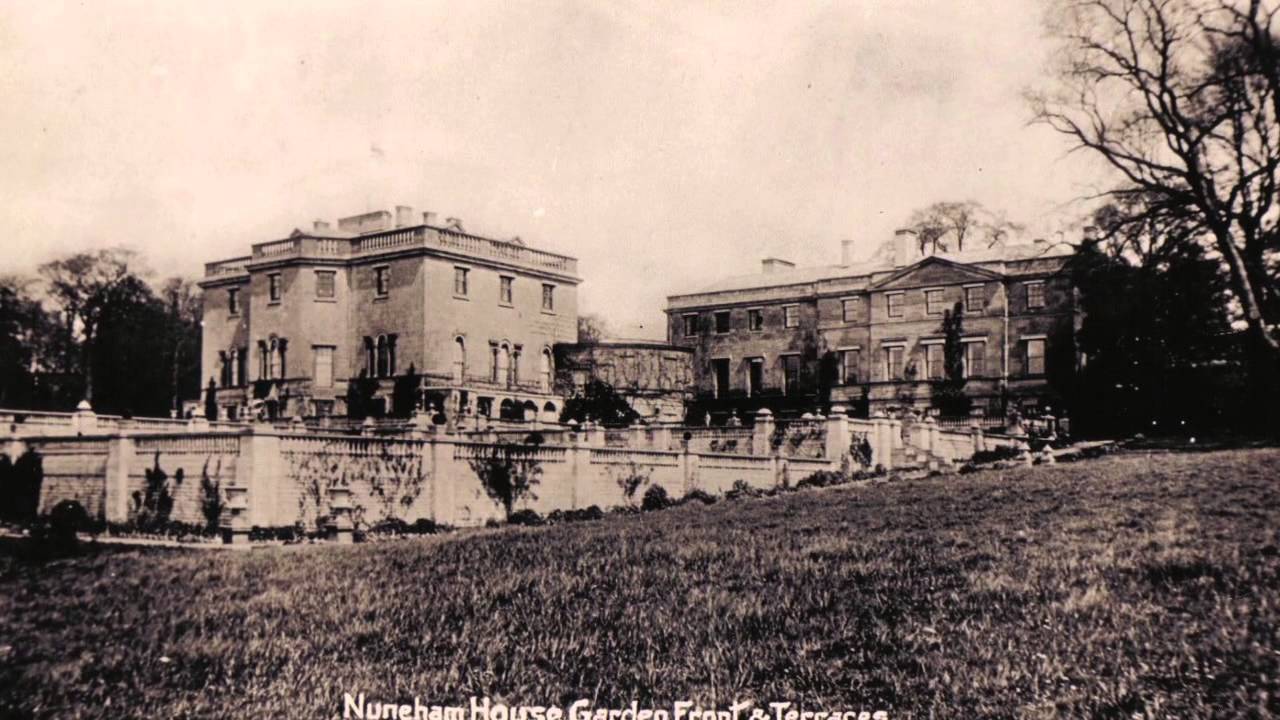Nuneham House is one of the finest examples of villa revival of the 1750s; it was built not for a newly rich banker, nor a country squire, but for Earl Harcourt, one of George III’s leading courtiers; not as an occasional retreat but a principal residence.
From the day it was built, there was a constant struggle between the restraints of the villa form and the size of the house expected by a nobleman. The subsequent history of the house is one of successive alterations, which turned a villa into a seat. The Harcourts were a conquest family whose original grant of land in Oxfordshire was Stanton Harcourt. Nuneham Courtenay was acquired much later by purchase.
“The cheapest pennyworth that was ever bought in Oxfordshire.”
The manor of Nuneham had changed hands many times since it was held by the Courtenays and it was from Sir John Robinson that Sir Simon (later Viscount) Harcourt, the successful Solicitor General and Lord Chancellor under Queen Anne, bought the estate in 1712 for £17,000.
“The cheapest pennyworth that was ever bought in Oxfordshire.”
Simon Harcourt was born in 1714 and succeeded his grandfather, the Lord Chancellor, as the 2nd Viscount Harcourt in 1727. Throughout his life, he was a consummate courtier, created Earl Harcourt in 1749 and a Privy Councillor in 1751; he was governor of the Prince of Wales, the future George III, from 1751 to 1752.

A colourful past can be traced by some key dates:
1727
 The 1st Earl Harcourt inherited the ideal situation for a villa, “… advantageous and delicious as can be desired, being seated on a hillock of most easy ascent, at the foot of which lies a navigable river and on the other side surrounded by several hills that seem to form an amphitheatre.”
The 1st Earl Harcourt inherited the ideal situation for a villa, “… advantageous and delicious as can be desired, being seated on a hillock of most easy ascent, at the foot of which lies a navigable river and on the other side surrounded by several hills that seem to form an amphitheatre.”
1756
Stiff Leadbetter began work on a villa and Athenian Stuart was commissioned to decorate the interior of the house. The tumbledown village, which stood on the site, was pulled down and rebuilt on the London Road.
1777-1781
 The 2nd Earl inherited a formal Palladian villa with classical gardens, and immediately hired Capability Brown to improve the landscape and make alterations to the house. William Mason laid out a picturesque flower garden and Brown created a series of views over the water meadows to the spires of Oxford as the house was completely remodelled.
The 2nd Earl inherited a formal Palladian villa with classical gardens, and immediately hired Capability Brown to improve the landscape and make alterations to the house. William Mason laid out a picturesque flower garden and Brown created a series of views over the water meadows to the spires of Oxford as the house was completely remodelled.
1786
 Fanny Burney accompanied George III and Queen Charlotte on a visit. The King called Nuneham, “the most enjoyable place I know,” but Miss Burney described the house as a “straggling, half-new, half-old, half-comfortable, half-forlorn mansion.”
Fanny Burney accompanied George III and Queen Charlotte on a visit. The King called Nuneham, “the most enjoyable place I know,” but Miss Burney described the house as a “straggling, half-new, half-old, half-comfortable, half-forlorn mansion.”
1832
Archbishop Harcourt found Brown’s house quite inadequate for “modern notions of comfort,” and Smirke was engaged to build a new wing.
1841
 Queen Victoria stayed at Nuneham shortly after her wedding, and wrote, “This is a most lovely place; pleasure grounds in the style of Claremont, only much larger, and with the Thames winding along beneath them, and Oxford in the distance; a beautiful flower garden and kitchen garden, and all kept up in perfect order.”
Queen Victoria stayed at Nuneham shortly after her wedding, and wrote, “This is a most lovely place; pleasure grounds in the style of Claremont, only much larger, and with the Thames winding along beneath them, and Oxford in the distance; a beautiful flower garden and kitchen garden, and all kept up in perfect order.”
1863
 Nuneham Park served as the setting for several chapters of ‘Through The Looking Glass’ by Revd. Charles Dodgson, also known to the world as Lewis Carroll. Alice Liddell (the real Alice) later recalled, “Most of Mr Dodgson’s stories were told to us on river expeditions to Nuneham and Godstow.”
Nuneham Park served as the setting for several chapters of ‘Through The Looking Glass’ by Revd. Charles Dodgson, also known to the world as Lewis Carroll. Alice Liddell (the real Alice) later recalled, “Most of Mr Dodgson’s stories were told to us on river expeditions to Nuneham and Godstow.”
1889
Jerome K Jerome wrote, “Nuneham Park is well worth a visit the grounds are very beautiful.” (Three Men in a Boat).
1904
 Sir William Harcourt, who as Chancellor of the Exchequer had introduced death duties in 1894, unexpectedly inherited Nuneham (by then rather dilapidated). “I appear to have inherited a bankrupt estate,” he remarked. To which the agent replied, “And whose fault do you think that is, Sir William?” He died shortly afterwards and his son, Lewis, again remodelled the house and also created a terraced garden.
Sir William Harcourt, who as Chancellor of the Exchequer had introduced death duties in 1894, unexpectedly inherited Nuneham (by then rather dilapidated). “I appear to have inherited a bankrupt estate,” he remarked. To which the agent replied, “And whose fault do you think that is, Sir William?” He died shortly afterwards and his son, Lewis, again remodelled the house and also created a terraced garden.
1942
The house was requisitioned by the RAF and used until 1957 as the Central Interpretation Unit for air surveillance photography. Many wartime photographic interpreters received their training in the mansion.
1948
Lord William Harcourt sold Nuneham Estate to the University of Oxford
1968
After extensive restoration, the house became a Hall of Residence for Culham College of Education.
1978 – 1979
 The house and gardens were leased to Rothmans International and one year was spent on a programme of complete restoration and renovation; the exterior was cleaned and refaced; the great central staircase restored and, while preserving the beauty and shape of the original mansion, the residential areas were completely rebuilt.
The house and gardens were leased to Rothmans International and one year was spent on a programme of complete restoration and renovation; the exterior was cleaned and refaced; the great central staircase restored and, while preserving the beauty and shape of the original mansion, the residential areas were completely rebuilt.
1980
Nuneham Park Conference Centre opened its doors in January, but work continued in the gardens to restore them to something of their former glory.
1993
Leased by the Brahma Kumaris World Spiritual University, Nuneham Park begins its new role as the Global Retreat Centre.
